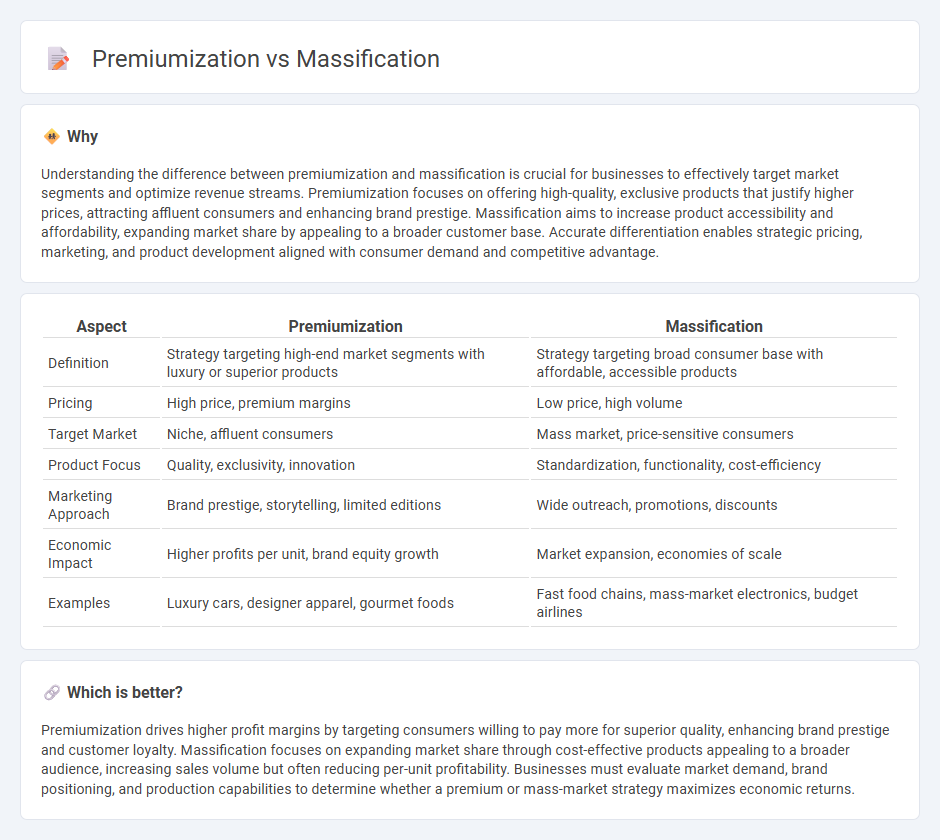
Premiumization drives economic growth through increased consumer spending on high-quality, luxury goods and services, reflecting rising disposable incomes and shifting preferences. Massification, on the other hand, focuses on expanding market reach by offering affordable products to a broader audience, promoting volume sales and economies of scale. Explore the impacts of premiumization versus massification on global economic trends and consumer behavior to understand their strategic significance.
Why it is important
Understanding the difference between premiumization and massification is crucial for businesses to effectively target market segments and optimize revenue streams. Premiumization focuses on offering high-quality, exclusive products that justify higher prices, attracting affluent consumers and enhancing brand prestige. Massification aims to increase product accessibility and affordability, expanding market share by appealing to a broader customer base. Accurate differentiation enables strategic pricing, marketing, and product development aligned with consumer demand and competitive advantage.
Comparison Table
| Aspect | Premiumization | Massification |
|---|---|---|
| Definition | Strategy targeting high-end market segments with luxury or superior products | Strategy targeting broad consumer base with affordable, accessible products |
| Pricing | High price, premium margins | Low price, high volume |
| Target Market | Niche, affluent consumers | Mass market, price-sensitive consumers |
| Product Focus | Quality, exclusivity, innovation | Standardization, functionality, cost-efficiency |
| Marketing Approach | Brand prestige, storytelling, limited editions | Wide outreach, promotions, discounts |
| Economic Impact | Higher profits per unit, brand equity growth | Market expansion, economies of scale |
| Examples | Luxury cars, designer apparel, gourmet foods | Fast food chains, mass-market electronics, budget airlines |
Which is better?
Premiumization drives higher profit margins by targeting consumers willing to pay more for superior quality, enhancing brand prestige and customer loyalty. Massification focuses on expanding market share through cost-effective products appealing to a broader audience, increasing sales volume but often reducing per-unit profitability. Businesses must evaluate market demand, brand positioning, and production capabilities to determine whether a premium or mass-market strategy maximizes economic returns.
Connection
Premiumization drives consumers to seek higher-quality, exclusive products, increasing market segmentation and enabling brands to target affluent segments effectively. Massification, on the other hand, expands product availability and accessibility to broader consumer groups by leveraging economies of scale and cost efficiencies. Together, these trends balance market differentiation and inclusivity, fueling economic growth through diversified demand and optimized supply chains.
Key Terms
Market Segmentation
Massification targets broad consumer groups with affordable products, emphasizing economies of scale and widespread accessibility. Premiumization focuses on niche segments seeking high-quality, exclusive offerings that justify higher prices through superior features and brand prestige. Explore deeper insights into how market segmentation drives these contrasting strategies.
Consumer Behavior
Consumer behavior reveals distinct preferences between massification and premiumization, with massification appealing to price-sensitive consumers seeking value and accessibility, while premiumization targets discerning customers prioritizing quality, exclusivity, and brand prestige. Market trends show increased demand for personalized experiences and ethical products, influencing buying decisions in both segments. Explore in-depth insights on how consumer psychology shapes these evolving market dynamics.
Value Proposition
Massification emphasizes affordability and broad accessibility, targeting large consumer segments with standardized products that maximize cost efficiency. Premiumization focuses on delivering superior quality, exclusivity, and enhanced features, appealing to niche markets willing to pay a premium for unique value and personalized experiences. Explore how aligning your value proposition with either strategy can drive competitive advantage and market growth.
Source and External Links
Trends in United States Higher Education from Massification to Post ... - Massification in higher education refers to the rapid expansion in enrollment and institutional growth during the 1960s to mid-1970s, driven by social mobility, economic growth, and expanded access for underrepresented populations in the US.
Atomization versus Massification in Transportation Modes - Massification describes increasing the capacity to move large load units or large numbers of passengers in a single trip, emphasizing economies of scale in transport systems.
massification - International Higher Education - Massification in global higher education signifies the substantial increase in higher education access worldwide, with challenges like inequality and quality concerns amid its rapid expansion.
 dowidth.com
dowidth.com